In the solar industry, more and more maintenance issues are cropping up as PV systems age. It’s common to replace a damaged panel or repair a malfunctioning inverter. A customer might contact you to add legacy panels to their existing system. Or, you might assess a system and determine it’s time for an upgrade.
But is your company prepared to effectively handle the upkeep of PV systems? Do you know where to find replacement parts? What do you do with decommissioned equipment? To answer these questions, turn to the solar aftermarket.
This article gives contractors and O&M companies an inside look on the aftermarket. See how you can reap the rewards the aftermarket has to offer. Learn about five techniques for finding replacement parts. And explore resources for reselling and recycling decommissioned equipment.
What’s the solar aftermarket all about, and why should I care?
You’ve installed many new PV systems, which is great. But do you realize that some of your future revenue will come from your current customers? Welcome to the solar aftermarket. The aftermarket comprises any service or project that takes place after installation through equipment end-of-life.
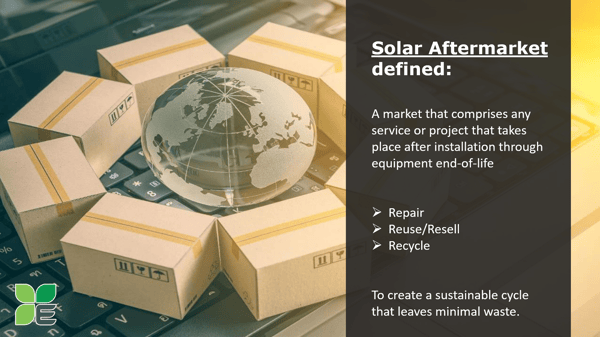
It’s hard to put a dollar value on the potential of the solar aftermarket with today’s focus on new installs. But we know from Harvard Business Review that “American businesses and consumers spend approximately $1 trillion every year on assets they already own.” Why would solar be any different?
Harvard Business Review goes on to say, “In industries such as automobiles, white goods, industry machinery and information technology, companies have sold so many units over the years that their aftermarkets have become four to five times larger than their original equipment businesses.” That figure doesn’t even take into account businesses and consumers throughout the world who buy second-hand PV equipment and direct materials from recycled goods.
The solar industry is striving for a sustainable cycle that leaves minimal waste. Note that the time of decommission may not be the product’s end-of-life. Between decommission and end-of-life, a robust solar aftermarket creates a fluid process of repair, reuse and recycle.
How big is today’s solar aftermarket?
As mentioned, analysts have not yet measured the economic potential of the solar aftermarket. But we can use industry numbers to reasonably conclude value exists.
In today’s global economy, there exists more than 480 gigawatts (GWdc) of installed photovoltaic (PV) modules. Looking back on 2008, global installed PV capacity totaled 13.9 GW with Germany in the lead (5.3 GW), followed by Spain (3.4 GW), Japan (2.1 GW), and the U.S. (1.1 GW). This capacity is now at least eleven years mature.
At minimum, these systems have repaired or replaced inverters. With changes in technology and code standards over the last decade, many of these older systems have probably been upgraded.
Five years later at the close of 2013, total global capacity hit right around 150 GW. U.S. capacity increased to 12.4 GW. Europe led the market with more than 60% of world capacity, followed by China and Asia-Pacific, then America. At this time, the aftermarket in Europe is starting to take off, as evidenced by the boom of e-commerce marketplaces like PVXchange and SecondSol.
Fast forward to present day, the global market has more than tripled capacity from 2013 levels. World leaders have shifted to Asia in first place, Europe in second and North America in third, as measured by capacity.
Today’s capacity demands a robust aftermarket that can (1) ensure adequate system performance and (2) create a sustainable cycle for decommissioned panels. This demand will increase as the industry continues to add capacity at record-breaking levels. How much capacity are we talking about? Analysts forecast world capacity to total 1.3 TW by 2023.
Why should I care?
Contractors and O&M companies alike have the opportunity to make money in the aftermarket. At EnergyBin, we talk to hundreds of solar companies every week. We often hear from installers that they don’t have time to explore what the aftermarket has to offer.
It’s common to get swept up in the demand for new installs. Left unplanned for, the difficulty of finding replacement parts and dealing with decommissioned equipment will disrupt your business operations and cost you money.
Any customer who has purchased a system from you will be your customer for life if they have a positive experience working with you. Expect to be the first person they call when something goes wrong with their system. Be ready to respond effectively and efficiently. If you drop the ball, you’ll lose that customer for future business. You’ll also risk that customer giving negative reviews about your company to anyone who will listen.
But taking care of your customers creates an opportunity for future business and a pipeline for referrals. A happy customer may decide to upgrade or add onto an existing system, or even build a new system down the road. More importantly, happy customers will recommend your company to new prospects.
Failure to take care of your customers will cost your business. Your competitors will gladly step in where you fall short. The Internet makes it easy for prospects and customers to read up on a company’s track record. Even if you have positive testimonials on your website, other sites such as social media, Google reviews, Yelp, and BBB may tell a different story.
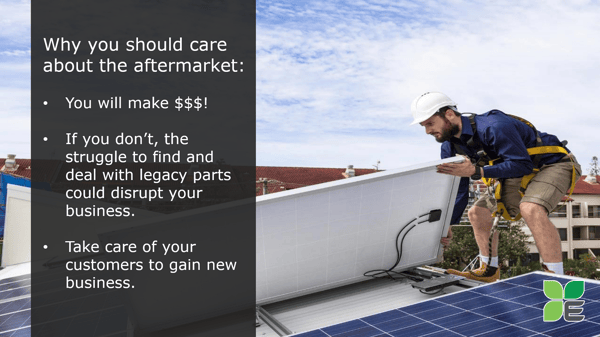
Convinced yet? From new business opportunities to retaining happy customers, devoting resources to the aftermarket strengthens your bottom line for the long-term.
Now that you’re thinking about the aftermarket, you may be wondering how to find replacement parts and what to do with decommissioned equipment. Let’s take a look at your options.
Where can I find replacement parts?
When a part malfunctions or is damaged, you have three main options to resolve the situation. You could repair the damaged part. You could replace the part with an exact match. Or, you could upgrade the system with new technology.
Repairing a damaged part may be optimal if you have a repair service in your area. Some insurance companies may require you to repair the part rather than replace it. Repair can also prove to be ideal if the part is a legacy model.
In cases where repair is not an option, you can either search for a replacement part or upgrade the system. If damage is minor and isolated to a single component, finding a replacement part may be the better option. If multiple components need replacement, it might make more sense to upgrade the entire system.
Whichever route you take, consider these five techniques to address your replacement needs.
| 5 Techniques to Find Replacement Solar Panels & Parts: |
| 1. Check with the manufacturer and your primary distributor. |
| 2. Call your industry colleagues. |
| 3. Message your social media network. |
| 4. Conduct a smart Internet search. |
| 5. Partner with a solar equipment broker. |
These techniques provide a road map for navigating the solar aftermarket. Whether you need replacement parts today or you’re planning for future needs, use these techniques to minimize down-time of solar systems and keep your customers happy.
1. Check with the manufacturer and your primary distributor.

Several manufacturers offer aftermarket services to their customers. For example, ABB and Fronius offer in-house repair programs for their inverters. Depending on turn-around time, service could prove to be your best route. Check with your manufacturer about in-house repair services.
In addition, some manufacturers and distributors keep older models in stock for the purpose of offering replacements to their customers.
Recently, an EnergyBin member - a developer - was looking for a pallet of Yingli modules for a replacement project on a utility-scale system. Due to the project parameters, the developer was unable to use a substitute module. Their EnergyBin representative reached out to Yingli and successfully located 70 exact match panels in New Jersey – the last of this particular model in Yingli’s stock.
Because this older stock does nothing for suppliers’ profits sitting in warehouses, they look for ways to sell the inventory through auctions, clearance sales and other channels.
Although the developer in our story lucked out with Yingli, be cautious of relying on your manufacturer or distributor for aging models.
If you use a specific model and are informed that it is discontinued, you may want to make a bulk purchase to have on-hand for O&M needs.
What happens if the manufacturer goes out of business? Obviously, you can’t pick up the phone and call them. What do you do when your primary distributor doesn’t have the part you need? You’ll have to turn to another technique to find replacement parts.
2. Call your industry colleagues.

It’s no secret that the solar industry is built on relationships. Chat with any industry professional, and you’ll tend to find help and advice. Even with the pressure of competition, professionals work together to advance clean energy throughout the world.
So, pick up the phone and make some calls. Ask your colleagues if they have the spare parts you are looking for, or if they know someone who could help. Check with all of your colleagues, not just suppliers.
One EnergyBin member - a residential installer - contacted another installer, also an EnergyBin member, to inquire about buying a few panels. He found out that the second installer had left-over parts from a recent project. The two installers completed a transaction – one obtaining the quantity he needed, and the other recouping cash on unused equipment.
The downside of this technique is carving out time to make calls. Even if you tell yourself you’ll spend the afternoon calling your colleagues, there’s no guarantee they’ll answer the phone. Sending emails could fill the gap, but emails can also go unanswered in today’s fast-paced industry.
Texting might be worth a try if you have colleagues’ cell phone numbers. However, we recommend only texting a colleague if you have received their permission to do so. An unwelcomed text message could dampen your relationship.
3. Message your social media network.

Another technique to locate replacement parts is leveraging your social media network. Most social media platforms allow you to send a personal message to anyone in your network.
LinkedIn is thought to be the most professional network in the social media world. It’s useful for sending a quick message to a colleague to ask for advice or pose a question. Keep your personal messages short and professional. Use proper grammar and spelling.
On LinkedIn, view your contacts’ connections. If you want to contact someone you are not connected to but your colleague is, ask him or her to introduce you.
You can also post a message to the public newsfeed or a specific group’s newsfeed, such as Solar Energy Network or Solar Power World. Use hashtags to ensure your post is seen by industry professionals. For instance, if you are looking for SolarWorld panel replacements, try using the hashtags, #SolarWorld and #pvsolar.
We came across a residential installer on LinkedIn who published a post inquiring about a specific replacement part model. We contacted him to share how EnergyBin could help locate the part. He joined our community and connected to another member who shipped the part to him the next day. We wouldn’t have known about his company were it not for LinkedIn.
Social media works best when you have the time to manage your accounts and comb through newsfeeds. The process of hunting down replacement parts via social media can be demanding. Your response rate depends on whether the contacts you are messaging are logged in.
4. Conduct a smart Internet search.
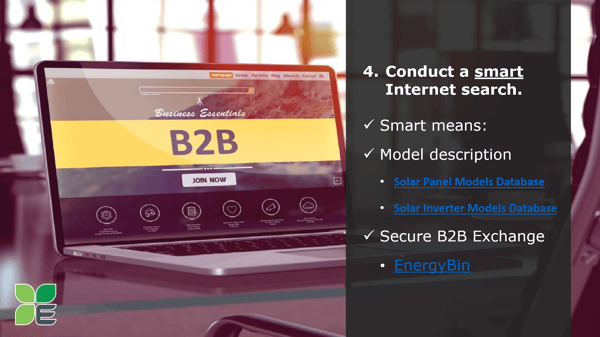
Before we dig into this technique, notice the word, “smart”. The Internet is a wealth of information. But if you don’t conduct a smart search, you’ll drown in results that may not even be relevant to what you are looking for.
Start by locating the model description for the replacement part you’re searching for. If you’re unsure what it is, refer to the Solar Panel Models Database and Solar Inverter Models Database. You can also skim through datasheets on the manufacturer’s website.
With your model description in-hand, you could type it into any search engine. But your results will display everything published online for that model. For example, say you’re looking for the replacement panel, LG315N1C-G4. Searching this model description on Google produces 3,190 results. At first, you think, “Oh good! This won’t take long to find a seller.”
Then, you start skimming the results. The first result is the panel datasheet on LG’s website. The second result is a retail e-commerce site. The third site is a seller listing a price 52% below MSRP, but they’re sold out. The fourth result is a product review.
Rather, a smart Internet search for LG315N1C-G4 would produce results for available product at a wholesale price. And because the Internet also harbors plenty of dishonest “entrepreneurs”, we’d add to a smart Internet search a secure trading platform.
Using a secure, B2B exchange like EnergyBin saves you time and gives you peace of mind as you deal with vetted members. On such an exchange, you see real-time inventory from thousands of members. Inventory listings are specific to PV technology and are traded at wholesale prices.
At present, if we search LG315N1C-G4 on EnergyBin, we get results from two sellers who have a total of 833 panels. We also see the corresponding datasheet linked to each inventory line.
Because an exchange is a trading platform where members are buying and selling every day, our results change as panels are sold and new inventory is listed.
What about the price? The sellers are listing between 63-70% below MSRP. That beats the other search result of 52% below MSRP.
What if you join an exchange only to find no member has the part you need? We advise EnergyBin members to send a notice to other members because they may be able to locate it through their networks.
Joining a secure, B2B exchange is a strategic way to ensure you have a go-to place to find replacement parts on a regular basis. Plus, you can leverage your membership to establish your presence in the solar aftermarket.
Want an sneak peek of EnergyBin?
5. Partner with a solar equipment broker.

As we alluded, it’s possible to strike out finding replacement parts by using the four techniques discussed, which brings us to the fifth and final technique. Partner with a solar equipment broker.
This profession is fairly new to the solar industry. Brokers, also known as traders, are active in other commodity industries where they trade new and used products day-in and day-out. The most common example is the real estate industry, where brokers represent buyers and sellers of homes.
Solar equipment brokers keep tabs on the best equipment deals and are masters of efficient supply chain processes. They have global access to products and excel in transportation logistics.
In a nutshell, a broker can help you find what you need. Partner with a broker and let them do the hard work of finding replacement parts for you. Connect with brokers through B2B communities like EnergyBin.
We heard of an EnergyBin member - a commercial contractor - who needed some niche racking for a project. They called their manufacturer and distributor, reached out to their contacts and searched on EnergyBin. But they couldn’t find the racking they needed. So, they decided to partner with another EnergyBin member - a broker - who scoured his global network to find the equipment. Within two weeks, the product was drop-shipped to the project site.
Perhaps you may also want to try your hand at equipment trade. You don’t need to be an expert broker to take advantage of this opportunity.
Leverage your membership in a B2B exchange to sell left-over equipment from projects. Request multiple quotes to present a variety of pricing options to your customers. Offer to resell equipment piled up in your colleague’s back room.
You might surprise yourself and discover a passion for brokering like one EnergyBin member did, who was a residential installer and now is a full-time broker.
What do I do with the decommissioned stuff?
Thus far, we’ve covered the importance of the solar aftermarket and five techniques for finding replacement parts in the aftermarket. When you successfully replace a damaged part or upgrade an aging system, you’re all done with the job – right? Wrong! You still need to take proper care of the decommissioned equipment.
Now, you may think the decommissioned equipment is the sole responsibility of the system owner. This mindset could be bad for your business. What company sells a new laundry machine to a customer, comes to install it, and leaves the old machine behind?
Packing out decommissioned equipment could be economically beneficial for your business. You leave your customer happy. You also play your part in completing the industry’s sustainable cycle by reselling or recycling the equipment.
Resell reusable equipment
Your economic opportunity lies in resale. Because panels have a lifespan of 40-50 years, there’s a good chance decommissioned panels have not yet met their end-of-life. Pending no major damage, panels can be resold. Buyers throughout the world are in the market for used panels priced between $0.05-0.15/Watt.
You can resell panels and other equipment by taking on the qualities of a broker. Online trading communities like EnergyBin make it easy for you to resell equipment. Follow the best practices of reputable resellers to start selling your used equipment today. If you need help, contact your friendly EnergyBin representative.
Recycle end-of-life equipment
For equipment that is truly at end-of-life, it’s important to recycle. By doing so, materials can be extracted for new components, and chemicals stay out of landfills.
How much material can be reused from the average c-Si module? Of the module’s makeup – 76% glass, 10% polymer, 8% aluminum, 5% silicon, 1% copper, and 0.1% silver, tin and lead – at least 82% is easy-to-recycle material today. As innovations to the PV recycling process develop, the percentage of reusable materials is expected to increase.
In the United States, many states are considering or have passed legislation that mandates PV recycling. Plan ahead for your business by familiarizing yourself with SEIA’s National PV Recycling Program. SEIA offers a free check-list to prepare for recycling PV equipment. You can also contact SEIA with any questions about recycling or for help finding a recycling partner near you.
Conclusion
By now, you have taken in a lot of information about the solar aftermarket. We’ve covered how to locate replacement parts and what to do with decommissioned equipment. Perhaps you’ve discovered some light bulb ideas to create new business opportunities in the aftermarket, such as solar equipment brokering.
Your next step is to think through what makes sense for your company’s long-term sustainability. What are you going to do to ensure you can operate efficiently and effectively in the aftermarket? What aftermarket practices do you need to establish to guarantee long-term customer satisfaction? Don’t wait until tomorrow; get involved in the aftermarket today.
If you’re ready to see how EnergyBin can help your company, request a demo.
Further Reading
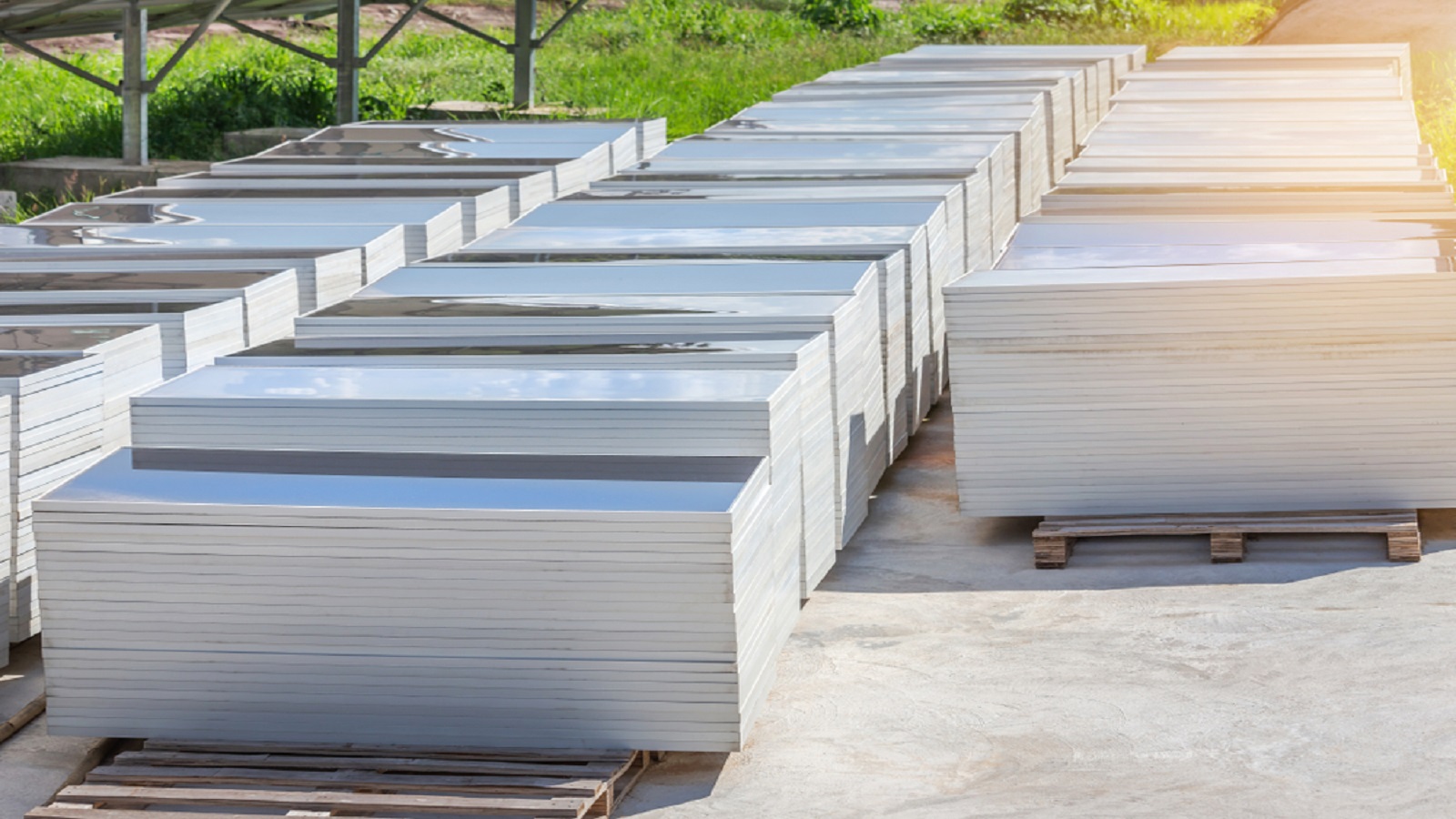

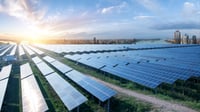 The Ultimate Guide to Buying Wholesale Solar
The Ultimate Guide to Buying Wholesale Solar